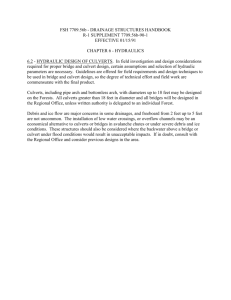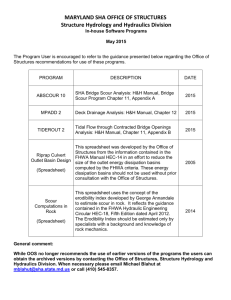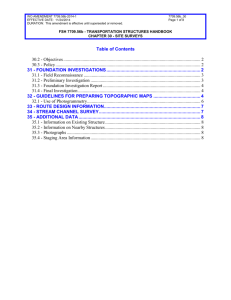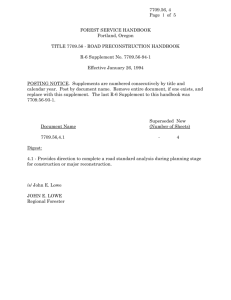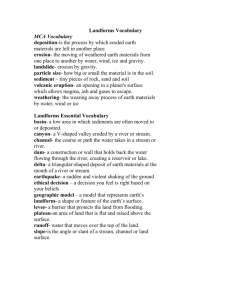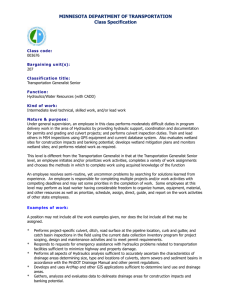wo_7709.56b_60 - USDA Forest Service
advertisement
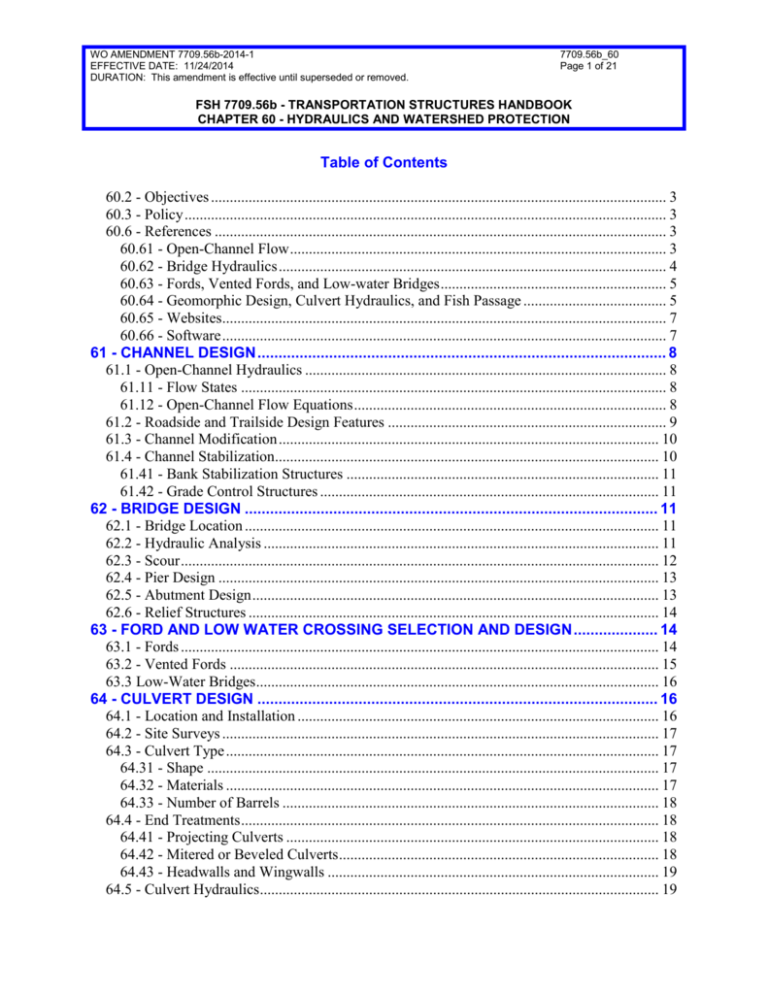
WO AMENDMENT 7709.56b-2014-1 EFFECTIVE DATE: 11/24/2014 DURATION: This amendment is effective until superseded or removed. 7709.56b_60 Page 1 of 21 FSH 7709.56b - TRANSPORTATION STRUCTURES HANDBOOK CHAPTER 60 - HYDRAULICS AND WATERSHED PROTECTION Table of Contents 60.2 - Objectives ......................................................................................................................... 3 60.3 - Policy ................................................................................................................................ 3 60.6 - References ........................................................................................................................ 3 60.61 - Open-Channel Flow .................................................................................................... 3 60.62 - Bridge Hydraulics ....................................................................................................... 4 60.63 - Fords, Vented Fords, and Low-water Bridges ............................................................ 5 60.64 - Geomorphic Design, Culvert Hydraulics, and Fish Passage ...................................... 5 60.65 - Websites...................................................................................................................... 7 60.66 - Software ...................................................................................................................... 7 61 - CHANNEL DESIGN ................................................................................................. 8 61.1 - Open-Channel Hydraulics ................................................................................................ 8 61.11 - Flow States ................................................................................................................. 8 61.12 - Open-Channel Flow Equations ................................................................................... 8 61.2 - Roadside and Trailside Design Features .......................................................................... 9 61.3 - Channel Modification ..................................................................................................... 10 61.4 - Channel Stabilization...................................................................................................... 10 61.41 - Bank Stabilization Structures ................................................................................... 11 61.42 - Grade Control Structures .......................................................................................... 11 62 - BRIDGE DESIGN .................................................................................................. 11 62.1 - Bridge Location .............................................................................................................. 11 62.2 - Hydraulic Analysis ......................................................................................................... 11 62.3 - Scour ............................................................................................................................... 12 62.4 - Pier Design ..................................................................................................................... 13 62.5 - Abutment Design ............................................................................................................ 13 62.6 - Relief Structures ............................................................................................................. 14 63 - FORD AND LOW WATER CROSSING SELECTION AND DESIGN .................... 14 63.1 - Fords ............................................................................................................................... 14 63.2 - Vented Fords .................................................................................................................. 15 63.3 Low-Water Bridges........................................................................................................... 16 64 - CULVERT DESIGN ............................................................................................... 16 64.1 - Location and Installation ................................................................................................ 16 64.2 - Site Surveys .................................................................................................................... 17 64.3 - Culvert Type ................................................................................................................... 17 64.31 - Shape ........................................................................................................................ 17 64.32 - Materials ................................................................................................................... 17 64.33 - Number of Barrels .................................................................................................... 18 64.4 - End Treatments ............................................................................................................... 18 64.41 - Projecting Culverts ................................................................................................... 18 64.42 - Mitered or Beveled Culverts ..................................................................................... 18 64.43 - Headwalls and Wingwalls ........................................................................................ 19 64.5 - Culvert Hydraulics.......................................................................................................... 19 WO AMENDMENT 7709.56b-2014-1 EFFECTIVE DATE: 11/24/2014 DURATION: This amendment is effective until superseded or removed. 7709.56b_60 Page 2 of 21 FSH 7709.56b - TRANSPORTATION STRUCTURES HANDBOOK CHAPTER 60 - HYDRAULICS AND WATERSHED PROTECTION 65 - AQUATIC ORGANISM PASSAGE DESIGN ......................................................... 19 65.1 - Design Priority: .............................................................................................................. 19 65.2 - Aquatic Organism Passage Design Methods .................................................................. 20 65.3 - Design Requirements for Aquatic Passage..................................................................... 20 WO AMENDMENT 7709.56b-2014-1 EFFECTIVE DATE: 11/24/2014 DURATION: This amendment is effective until superseded or removed. 7709.56b_60 Page 3 of 21 FSH 7709.56b - TRANSPORTATION STRUCTURES HANDBOOK CHAPTER 60 - HYDRAULICS AND WATERSHED PROTECTION 60.2 - Objectives To maintain stream channel integrity and function, maximize structure life, minimize structure maintenance, and optimize user safety while providing for appropriate species passage. Address watershed characteristics that currently influence, or have potential to influence, stream crossings. 60.3 - Policy To the extent possible, design bridges, culverts, and low-water crossings to accommodate the natural passage of ice, woody debris, water, sediment, and aquatic species; accommodate passage of terrestrial species where such passage is necessary; provide for ecological connectivity; and meet the intent of applicable laws and regulations. Bridges, culverts, and low-water crossings should minimize constriction, relocation, encroachment, and modification to stream channels, adjacent riparian vegetation, and floodplains. Where there are feasible opportunities, use channel and stream crossing designs to promote favorable stream channels and improve watershed conditions. Use an interdisciplinary process to develop site specific design criteria including, but not limited to, project limits, structure type, structure material type, width, elevations, and skew angle. Identify upstream and downstream watershed influences, the current and most probable geomorphic stream setting, and species passage needs. Identify risks to the watershed and local stream conditions created by the structure and mitigation measures to reduce those risks. 60.6 - References 60.61 - Open-Channel Flow 1. American Association of State Highway and Transportation Officials (AASHTO). Highway Drainage Guidelines. Current edition. AASHTO, 444 North Capitol Street, N.W., Suite 249, Washington, D.C. 20001. 2. AASHTO. Model Drainage Manual. Current edition. AASHTO, 444 North Capitol Street, N.W., Suite 249, Washington, D.C. 20001. 3. Chow, Ben Te. Open-Channel Hydraulics. Current edition. McGraw Hill, Inc., 1221 Avenue of the Americas, New York, NY 10020. WO AMENDMENT 7709.56b-2014-1 EFFECTIVE DATE: 11/24/2014 DURATION: This amendment is effective until superseded or removed. 7709.56b_60 Page 4 of 21 FSH 7709.56b - TRANSPORTATION STRUCTURES HANDBOOK CHAPTER 60 - HYDRAULICS AND WATERSHED PROTECTION 4. U.S. Department of Transportation, Federal Highway Administration (DOT-FHWA). Design Charts for Open-Channel Flow, Hydraulic Design Series No. 3 (HDS-3), FHWAEPD-86-102. 1961. Website: http://www.fhwa.dot.gov/engineering/hydraulics/index.cfm. 5. U.S. Department of Transportation, Federal Highway Administration (DOT-FHWA). Debris Control Structures Evaluation and Countermeasures, Hydraulic Engineering Circular No. 9 (HEC-9), FHWA-IF-04-01. 2005. Website: http://www.fhwa.dot.gov/engineering/hydraulics/index.cfm. 6. U.S. Department of Transportation, Federal Highway Administration (DOT-FHWA). Highways in the River Environment, Hydraulic Engineering Circular No. 16 (HEC-16), FHWA-HI-90-016. 1990. Website: http://www.fhwa.dot.gov/engineering/hydraulics/index.cfm. 7. U.S. Department of Transportation, Federal Highway Administration (DOT-FHWA). Bridge Scour and Stability Countermeasures Experience, selection, and Design Guidance, third edition, Hydraulic Engineering Circular No. 23 (HEC-23). FHWA-NHI-09-111. 2009. Website: http://www.fhwa.dot.gov/engineering/hydraulics/index.cfm. 8. U.S. Department of Agriculture, Forest Service. (USDA – FS) "National Best Management Practices for Water Quality Management on National Forest Lands”. Volume 1: National Core BMP Technical Guide. The web address to order this publication is: http://www.fs.fed.us/biology/resources/pubs/watershed/index.html 60.62 - Bridge Hydraulics 1. AASHTO. Highway Drainage Guidelines. Current Edition. AASHTO, 444 North Capitol Street, N.W., Suite 249, Washington, D.C. 20001. 2. U.S. Department of Agriculture, Forest Service. (USDA - FS). Bridge Scour Evaluation: Screening, Analysis, and Countermeasures. 7700 - Transportation Systems, September 1998, 9877 1207-SDTDC. http://www.fs.fed.us/eng/techdev/sdtdc.htm. 3. U.S. Department of Transportation, FHWA. Hydraulics of Bridge Waterways, Hydraulic Design Series No. 1 (HDS-1), FHWA-EDP-86-101. 1978. Website: http://www.fhwa.dot.gov/engineering/hydraulics/index.cfm. WO AMENDMENT 7709.56b-2014-1 EFFECTIVE DATE: 11/24/2014 DURATION: This amendment is effective until superseded or removed. 7709.56b_60 Page 5 of 21 FSH 7709.56b - TRANSPORTATION STRUCTURES HANDBOOK CHAPTER 60 - HYDRAULICS AND WATERSHED PROTECTION 4. U.S. Department of Transportation, FHWA. Evaluating Scour at Bridges, Hydraulic Engineering Circular No. 18 (HEC-18). FHWA-NHI-01-001. 2001. Website: http://www.fhwa.dot.gov/engineering/hydraulics/index.cfm. 5. U.S. Department of Transportation, FHWA. Stream Stability at Highway Structures, 3rd Edition, Hydraulic Engineering Circular No. 20 (HEC-20). FHWA-NHI-01-002. 2001. Website: http://www.fhwa.dot.gov/engineering/hydraulics/index.cfm. 60.63 - Fords, Vented Fords, and Low-water Bridges 1. U.S. Department of Agriculture, Forest Service. (USDA - FS). Use of Precast Concrete Ramp Planks For Low-Water Crossings, Engineering Field Notes, Volume 15, April-June 1983. 4. USDA-FS, Engineering Staff, P.O. Box 96090, Washington, DC 20090-6090. 2. U.S. Department of Agriculture, Forest Service. (USDA - FS). Low-Water Crossings: Geomorphic, Biological, and Engineering Design Considerations. Forest Service National Technology and Development Program, 2006. Website: http://www.fs.fed.us/eng/pubs/pdf/LowWaterCrossings 3. U.S. Department of Transportation, FHWA. Design and Construction of Low-Water Stream Crossings, Executive Summary, FHWA-RD-83-015. September 1983. The web address to order this publication is: http://www.fhwa.dot.gov/bridge/elibrary.htm. 60.64 - Geomorphic Design, Culvert Hydraulics, and Fish Passage 1. AASHTO. Highway Drainage Guidelines. Current Edition. AASHTO, 444 North Capitol Street, N.W., Suite 249, Washington, D.C. 20001. 2. AASHTO. Model Drainage Manual. Current edition. AASHTO, 444 North Capitol Street N.W., Suite 249, Washington, DC 20001. 3. American Iron and Steel Institute (AISI). Handbook of Steel Drainage and Highway Construction Products. Current edition. Published by AISI, 1000 16th Street N.W., Washington, DC 20036. 4. Federal Interagency Stream Restoration Working Group. 1988 Stream Corridor Restoration: Principles, Processes, and Practices. ISBN-0-934213-59-3. 5. Watts, F. J. Design of Culvert Fishways. Current edition. Available through the Water Resources Research Institute, University of Idaho, Moscow, Idaho 83843. WO AMENDMENT 7709.56b-2014-1 EFFECTIVE DATE: 11/24/2014 DURATION: This amendment is effective until superseded or removed. 7709.56b_60 Page 6 of 21 FSH 7709.56b - TRANSPORTATION STRUCTURES HANDBOOK CHAPTER 60 - HYDRAULICS AND WATERSHED PROTECTION 6. Knighton, D. Fluvial Forms and Processes. New York: John Wiley and Sons. 383p. 7. Montgomery, D. R., & Buffington, J. M. 1997. Channel-Reach Morphology in Mountain Drainage Basins. Geological Society of America Bulletin. 109p. 596-611. 8. Portland Cement Association (PCA). Handbook of Concrete Culvert Pipe Hydraulics. Current edition. PCA, 33 West Grand Avenue, Chicago, IL 60610. 9. Rosgen, D. 1996. Applied River Morphology. Pagosa Springs, CO. Wildland 8. Hydrology. 10. Somon, A. 1989. A Model of Channel Response in Disturbed Alluvial Channels. Earth Surface Process and Landforms. 14p. 11-26. 11. Rosgen, D. 2001. The Cross-Vane, W-Weir and J-Hook Structures: Their Description, Design and Application for Stream Stabilization and River Restoration. 12. U.S. Department of Agriculture, Forest Service. (USDA - FS). The Water/Road Interaction Series. San Dimas Technology Development Center. 1997. http://fsweb.mtdc.wo.fs.fed.us/search 13. U.S. Department of Agriculture, Forest Service. (USDA - FS). Stream Simulation: An Ecological Approach to Providing Passage for Aquatic Organisms at Road-Stream Crossings, Forest Service Stream-Simulation Working group, Forest Service National Technology and Development Program, 2008. http://www.fs.fed.us/eng/pubs/pdf/StreamSimulation/ 14. U.S. Department of Agriculture, Forest Service. (USDA – FS). Keeping Beavers From Plugging Culvert Inlets, Engineering Field Notes, Volume 18. January-February 1986. USDA-FS, Engineering Staff, P.O. Box 96090, Washington, DC 20090-6090. 15. U.S. Department of Transportation, Federal Highway Administration (DOT-FHWA). Hydraulic Design of Highway Culverts, Hydraulic Design Series No. 5 (HDS-5), FHWANHI-01-020. 2005. http://www.fhwa.dot.gov/engineering/hydraulics/index.cfm. 16. U.S. Department of Transportation, Federal Highway Administration (DOT-FHWA). Culvert Design for Aquatic Organism Passage, Hydraulic Engineering Circular No. 26 (HEC-26). FHWA-HIF-11-008. 2010. http://www.fhwa.dot.gov/engineering/hydraulics/index.cfm WO AMENDMENT 7709.56b-2014-1 EFFECTIVE DATE: 11/24/2014 DURATION: This amendment is effective until superseded or removed. 7709.56b_60 Page 7 of 21 FSH 7709.56b - TRANSPORTATION STRUCTURES HANDBOOK CHAPTER 60 - HYDRAULICS AND WATERSHED PROTECTION 60.65 - Websites 1. FHWA - Hydraulic Engineering Website: http://www.fhwa.dot.gov/engineering/hydraulics/index.cfm. 2. FHWA - Western Federal Lands Website: http://www.wfl.fhwa.dot.gov/resources/hydraulics/fishpassage/bibliography.htm. 3. NRCS - Hydraulics and Hydrology Website: http://www.wsi.nrcs.usda.gov/products/W2Q/H&H/H&H_home.html. 4. U.S. Army Corps of Engineers–Hydrologic Engineering Center (HEC) Website: http://www.hec.usace.army.mil/. 5. U.S. Department of Agriculture Forest Service, Stream Systems Technology Center Website: http://www.stream.fs.fed.us/. 6. U.S. Department of Agriculture Forest Service, National T&D Publications Website: http://fsweb.mtdc.wo.fs.fed.us/search/. 7. U.S. Geological Survey, Office of Surface Water Website: http://water.usgs.gov/osw/techniques/indirect.html. 8. U.S. Geological Survey, Water Resources Website: http://water.usgs.gov/. 60.66 - Software 1. U.S. Army Corps of Engineers. Hydrologic Engineering Centers River Analysis System (HEC-RAS). http://www.hec.usace.army.mil/software/hec-ras/. 2. U.S.D.A-FS. Stream Systems Technology Center, WinXSPRO: A Channel CrossSection Analyzer. http://www.stream.fs.fed.us/publications/winxspro.html. 3. DOT-FHWA. HY-7, Bridge Waterways Analysis Model, Micro Computer Software, FHWA-WSPRO. Current version. http://www.fhwa.dot.gov/engineering/hydraulics/software/softwaredetail.cfm#hy7. 4. DOT-FHWA. HY-8, FHWA Culvert Analysis, Micro Computer Software, FHWAHY-8. Current version. http://www.fhwa.dot.gov/engineering/hydraulics/software/hy8/. 5. U.S. Geological Survey. National Streamflow Statistics Program. http://water.usgs.gov/software/NSS/. WO AMENDMENT 7709.56b-2014-1 EFFECTIVE DATE: 11/24/2014 DURATION: This amendment is effective until superseded or removed. 7709.56b_60 Page 8 of 21 FSH 7709.56b - TRANSPORTATION STRUCTURES HANDBOOK CHAPTER 60 - HYDRAULICS AND WATERSHED PROTECTION 61 - CHANNEL DESIGN Channels should be designed to use a combination of geomorphic and hydraulic principles and approaches. Use the same hydraulic principles to analyze both natural stream and manmade channels through structures or channel section to be restored relative to water surface profiles, flow and velocity distributions, lateral and vertical stability of the channel, sediment mobility/stability, flood risk, and the potential reaction of the stream to changes in alignment, shape, or slope. 61.1 - Open-Channel Hydraulics 61.11 - Flow States Determine appropriate flow states using criteria and equations outlined in "Open-Channel Hydraulics" (Chow) (sec. 60.6). Open-channel flow is usually classified as one or a combination of: 1. Steady or unsteady flow, or 2. Uniform or non-uniform flow, or 3. Subcritical or supercritical flow. See the zero code of this handbook for definitions of flow states. Steady and uniform flow seldom occurs in nature. However, Engineers generally use the simplifying assumption of steady and uniform flow to simplify hydraulic calculations. This assumption would not be valid for flow during a dam failure or breach where steady and uniform flow obviously does not occur. Steady, but non-uniform flow generally occurs at restrictions in the channel, such as at some bridge locations. Use engineering judgment to ensure that the use of simplifying assumptions will not result in inaccurate calculations. Stable natural stream channels should always exist in subcritical flow conditions. Supercritical flow is only experienced with isolated hydraulic situations such as hydraulic jumps, channel obstructions, and constrictions. Design channels should mimic these subcritical flow conditions. 61.12 - Open-Channel Flow Equations As appropriate, use the following basic equations from "Open-Channel Hydraulics" (Chow) and "Guide for Selecting Manning's Roughness Coefficients for Natural Channels and Flood Plains" (FHWA TS-84-204) (sec. 60.6) to determine flows for the hydraulic design of open-channels: 1. Manning's Equation. Use Manning's Equation to make uniform flow and gradually varied flow calculations and to calculate normal depth in an open channel. (Normal depth is the depth of flow for uniform flow for a given cross-section, roughness, and WO AMENDMENT 7709.56b-2014-1 EFFECTIVE DATE: 11/24/2014 DURATION: This amendment is effective until superseded or removed. 7709.56b_60 Page 9 of 21 FSH 7709.56b - TRANSPORTATION STRUCTURES HANDBOOK CHAPTER 60 - HYDRAULICS AND WATERSHED PROTECTION slope.) The most difficult part of using Manning's Equation is selecting the appropriate channel roughness coefficient, "n". Always validate numeric outputs for realistic values. Average stable channel conditions are always in a subcritical flow scenario, and most stream channels will have bankfull velocities ranging from 3-6 fps. If realistic values are not generated, the roughness coefficient or perhaps other variables should be adjusted. Use actual discharge measurements to back calculate Mannings to calibrate flow models and perform a Froude number check to validate subcritical flow regime. 2. Energy Equation. Use the Energy Equation, or results derived from it, for calculating gradually varied flow in channels, for determining backwater elevations, and for calculating headwater for culverts in outlet control. 3. Momentum Equation. Use the Momentum Equation, or results derived from it, for calculating rapidly varied flow in the design of energy dissipaters. 4. Continuity Equation. Use the Continuity Equation, or results derived from it, for calculating all types of flow conditions in channels and for determining backwater elevations and upstream effects due to storage. Use commercially available charts and computer programs (available from the Federal Highway Administration, State highway departments, and private vendors) to simplify and speed calculations using these equations. For additional procedures see "Design Charts for Open-Channel Flow" (FHWA HDS-3) (sec. 60.6).6.11 - Stage Discharge Curves. Use a stage discharge curve to display the elevations of the water surface at a particular cross-section for different discharges. Develop a stage discharge curve to find channel freeboard, to predict flooding, or to determine culvert tailwater elevations. 61.2 - Roadside and Trailside Design Features Ditches along the side of the traveled way either prevent water from reaching the traveled way or drain water that would otherwise collect on the traveled way. Design ditches to carry flows commensurate with the Road Management Objectives (RMOs, FSM 7714) and Trail Management Objectives (TMOs). Ensure that side features are stable for the selected flows. Ditches and associated structures should be designed and maintained to be disconnected from the natural stream system with adequate buffer distances and/or devices to eliminate or reduce sediment delivery to streams. This is best achieved through frequent cross drains that discharge onto stable areas of the forest floor allowing water to infiltrate into the ground. Design cross drain alignment to maintain sediment transport to the extent possible by skewing and sloping. Sediment buffering devices, such as low-profile slash filter windrows, coir rolls, straw bales, and so forth, should be used at the outlets of cross-drains to trap sediment when sediment has the potential to be delivered to a stream or wetland. For further information on traveled way drainage, see FSH 7709.56, section 44. WO AMENDMENT 7709.56b-2014-1 EFFECTIVE DATE: 11/24/2014 DURATION: This amendment is effective until superseded or removed. 7709.56b_60 Page 10 of 21 FSH 7709.56b - TRANSPORTATION STRUCTURES HANDBOOK CHAPTER 60 - HYDRAULICS AND WATERSHED PROTECTION 61.3 - Channel Modification Streams are dynamic and extremely powerful; attempts at stream modification are expensive, frequently create unintended consequences, and are often only temporary. Every attempt should be made to move the route and structure to a stable location rather than manipulate the stream. Channel modifications should only be attempted with an interdisciplinary team as a last resort and should not be manipulated beyond natural geomorphic ranges of profile, pattern, and dimension. When manipulated beyond natural geomorphic ranges, streams that have been stable for years frequently can respond by several outcomes such as head-cutting, straightening, widening, meandering, down cutting, or aggrading. Perform a geomorphic assessment to identify the critical design information required for channel modifications. 61.4 - Channel Stabilization Use interdisciplinary expertise to characterize and properly identify stabilization issues and remedies. Assure that both causal and symptomatic mechanisms of the instability are understood and addressed by performing a geomorphic assessment. Avoid placing roads, trails, or structures across or immediately adjacent to unstable or braided channels, across debris flow or avalanche paths or on alluvial fans. Channel stabilization designs should be developed by an experienced interdisciplinary team. Check upstream and downstream stability at any proposed stream crossing by identifying potential bank sloughing, head cutting, aggradation, or down cutting. Where stream stabilization may be necessary, all design components should be designed to address identified failure mechanisms such as, but not limited to, flanking, channel down cutting, local scour, or systemic down cutting. Consider the stabilization method relative to efficacy of both local and systemic dynamics. Localized spot stabilization may fail or be expensive to maintain if they are located within long reaches of unstable channels. Understand the dynamics of discontinuous grades above and below the stream crossing. When replacing a culvert with a bottomless structure, assure that adequate grade control is used to avoid head cutting through the structure. Select stabilization measures based on an evaluation of the slope, velocity, shear stress on the channel and bank, projected scour, grain size of the bed load, bed and bank material, design flood water surface elevations, volume and type of debris, whether the channel is horizontally or vertically unstable, and experience with stabilization efforts in the area. Every attempt should be made to adjust the structure to the natural or most probable stable long profile elevation of the stream channel. Attempts to change a streams elevation beyond natural geomorphic ranges for the valley and local setting controls are expensive and frequently temporary. WO AMENDMENT 7709.56b-2014-1 EFFECTIVE DATE: 11/24/2014 DURATION: This amendment is effective until superseded or removed. 7709.56b_60 Page 11 of 21 FSH 7709.56b - TRANSPORTATION STRUCTURES HANDBOOK CHAPTER 60 - HYDRAULICS AND WATERSHED PROTECTION 61.41 - Bank Stabilization Structures Many types of stabilization structures exist. Consult with appropriate resource specialists to decide which structures best accommodate the channel relative to the remedy and the risk. Harden or protect banks only to a level of protection necessary to address the desired risk and public safety. Incorporate vegetation whenever possible. Avoid activities that remove or retard natural bank vegetation and deep rooting strengths. If stream banks are unstable and horizontal movement and erosion must be retained, utilize natural materials whenever possible and minimize the extent of hardened structures. When hardened structures are used, use natural channel design techniques that work with natural stream processes and cross-section hydraulics whenever possible. 61.42 - Grade Control Structures Use grade control structures as needed to avoid or control vertical instability, head cutting, and undermining of structure components. Understand and design for the causal mechanism of vertical instability in both local and systemic contexts. Utilize structures that provide for natural flow and sediment transport hydraulics. Natural channel design techniques will in most cases be the desired approach. Design structures in context to reduce the risk of identified potential failure mechanisms such as flanking, local scour, and down cutting. If techniques other than natural channel design approaches are used, assure the grade control structure(s) do not interfere natural flow hydraulics or with passage requirements for aquatic organisms. 62 - BRIDGE DESIGN Hydraulic design of bridges is site specific and varies by geographic and geomorphic area. Use the following general requirements, modified as necessary by Regions and Forest guidance. 62.1 - Bridge Location Direction on bridge location is found in chapter 20 of this Handbook. 62.2 - Hydraulic Analysis Perform hydraulic analyses of the design discharges for road and trail bridges and Aquatic Organism Passage structures to determine the: 1. Headwater elevation just upstream from the bridge. 2. Water surface profile upstream from the bridge, with and without the proposed bridge. 3. Freeboard clearance. WO AMENDMENT 7709.56b-2014-1 EFFECTIVE DATE: 11/24/2014 DURATION: This amendment is effective until superseded or removed. 7709.56b_60 Page 12 of 21 FSH 7709.56b - TRANSPORTATION STRUCTURES HANDBOOK CHAPTER 60 - HYDRAULICS AND WATERSHED PROTECTION 4. Depth of overtopping of the road or trail and the associated design discharge. 5. Velocity of flow transitioning upstream, through the bridge opening, and downstream. Bridge openings should not restrict the bankfull stream width. Consider sloping abutment fills to create spill through openings to improve flow efficiency and reduce scour potential. The bridge opening should also account for freeboard above the maximum design flood event’s upstream water surface elevation. A minimum freeboard of three feet is recommended for most structures. If large floating debris is possible, half a typical root wad, or half a typical log should be added to the minimum three foot freeboard to provide clearances. A minimum freeboard to accommodate boat, canoe, and floater recreation use should be five feet. Use the HEC-RAS, “Hydrologic Engineering Center – River Analysis System” or a similar program that may be available to model the water surface profile through the bridge opening. Bridge openings should be sized to pass the 100-year flood event with an appropriate freeboard and considering debris and sediment passage and blocking if applicable. The hydraulic model should consider debris blockage in the analysis. If site specific debris data is not available, a 30-50 percent blockage of the bridge opening using ineffective flow areas can account for debris blockages. Debris blockage should be considered if there is history or probability of transported debris or high intensity wildfire. Modeling contraction and expansion coefficients should be 0.1 and 0.3 for most channels and 0.3 and 0.5 for the cross sections nearest the bridge. The 2-year flood flow event, bankfull or the flow corresponding to the clear Ordinary High Water (OHW) geomorphic indicators should be used to determine the OHW surface elevation. This design elevation should be confirmed with existing OHW or bankfull at the site as validation of the design discharges. If elevations of predicted and existing OHW or bankfull are not similar, then further refinement of the design discharges is necessary. Temporary construction detour drainage structures should be sized to pass the 2-year flood flow, bankfull flow or the peak flow anticipated during the time of year construction will occur based on a hydrologic analysis of the site and nearby stream gages, unless provisions are in place to remove the structure during seasonal high-water. 62.3 - Scour For details on estimating and reducing scour, see the following: 1. “Bridge Scour Evaluation: Screening, Analysis, and Countermeasures” (USDA-FS) (sec. 60.6). 2. "Evaluating Scour at Bridges" (FHWA HEC-18) (sec. 60.6). WO AMENDMENT 7709.56b-2014-1 EFFECTIVE DATE: 11/24/2014 DURATION: This amendment is effective until superseded or removed. 7709.56b_60 Page 13 of 21 FSH 7709.56b - TRANSPORTATION STRUCTURES HANDBOOK CHAPTER 60 - HYDRAULICS AND WATERSHED PROTECTION 3. "Highways in the River Environment" (FHWA HEC-16) (sec. 60.6). 4. "Stream Stability at Highway Structures" (FHWA HEC-20) (sec. 60.6). Validate predicted scour with existing channel information. Evaluate the longitudinal profile and sediment size and mobility in the reference channel reaches to provide a check of scour depth that occurs naturally in the stream. Investigate local maximum scour depths in the existing channel, realizing that substrate deposition during recession of the peak flood commonly occurs, which reduces the measured maximum scour. Placement of structure elements in dynamic stream channels commonly has greater scour potential at flood flows than the natural stream because of greater flow constriction and higher shear stresses. 62.4 - Pier Design Eliminate piers when possible. Consider the following when piers must be constructed: 1. Pier Width and Length. Minimize the area a pier presents to the flow to decrease backwater and local scour. 2. Pier Shape. Streamline the pier so that it produces less backwater and scour potential and so that it catches less debris. 3. Alignment. Align piers with the maximum design flood flow to produce less backwater and scour and to catch less debris. Use geomorphology, aerial photographs and other available site specific data to determine appropriate pier alignment. Avoid using multiple pier bents that are not aligned to the stream flow since they catch debris, which in turn increases local scour and backwater. 4. Location. Pier location affects the debris catching characteristics of a bridge. Avoid placing piers in the center of streams that carry a large amount of debris where velocity and debris concentration is highest. Consider alternatives, such as using a three-span bridge with two short spans and one long central span or using two unequal spans to avoid placing a pier in the center of the stream. 62.5 - Abutment Design Choose either a vertical or spill-through abutment depending on economic and structural considerations and in accordance with the following conditions: 1. Spill through abutments is preferred and may minimize scour impacts. 2. Vertical abutments should have wing walls to improve scour resistance. 3. Align abutments with the flow to reduce backwater and to avoid excessive scour. WO AMENDMENT 7709.56b-2014-1 EFFECTIVE DATE: 11/24/2014 DURATION: This amendment is effective until superseded or removed. 7709.56b_60 Page 14 of 21 FSH 7709.56b - TRANSPORTATION STRUCTURES HANDBOOK CHAPTER 60 - HYDRAULICS AND WATERSHED PROTECTION 4. Locate spill-through abutments so that the toe of the embankment is equal to or greater than bank full width and does not constrict the main channel. 5. Design riprap or other appropriate countermeasures based on maximum design flood flow velocities and shear with debris blockages that may accelerate flows. If the channel and banks are stable, riprap or other appropriate countermeasures should be installed within areas of channel and bank disturbance. Riprap mat thickness must be a minimum of twice the average rock size of the riprap class/gradation or D50. A layer of geotextile may be placed under the riprap layer. 62.6 - Relief Structures Consider using relief structures on wide floodplains with large amounts of overbank flow. Relief structures allow floodplains to drain without using lateral channels along the upstream embankment slope. Relief structures also distribute the flow across the floodplain, reducing constriction losses and increasing the efficiency of the structures. Relief structures reduce abutment scour described in section 62.3. 63 - FORD AND LOW WATER CROSSING SELECTION AND DESIGN Use these structures only when their installation is consistent with the RMOs and TMOs. Consider the need for depth markers to warn of dangerous crossing conditions. Install fords or low-water structures if traffic can be interrupted during floods and the structure can be built to prevent frequent severe damage. Designs must meet aquatic organism passage requirements including low flow depth needs and minimum jump limits. Consult U.S. Department of Agriculture, Forest Service. Low-Water Crossings: Geomorphic, Biological, and Engineering Design Considerations. Forest Service National Technology and Development Program, 2006. 63.1 - Fords Use paved or natural fords under the following conditions: 1. Traffic can be interrupted during periods of mild to severe flooding. 2. Fisheries and water quality requirements allow vehicles to enter the stream. 3. The normal daily flow is less than 6 inches deep. 4. When there is extreme variation in normal flow to flood flow levels. WO AMENDMENT 7709.56b-2014-1 EFFECTIVE DATE: 11/24/2014 DURATION: This amendment is effective until superseded or removed. 7709.56b_60 Page 15 of 21 FSH 7709.56b - TRANSPORTATION STRUCTURES HANDBOOK CHAPTER 60 - HYDRAULICS AND WATERSHED PROTECTION If a stream has a flat slope and a rock or gravel bottom, construct a natural ford by merely dropping the grade to the stream bottom. On streams with steep slopes, or with rough, rocky, or soft sandy bottoms, level the bottom with coarse gravel. Except in very low gradients, a grade step will occur at the ford site. To dissipate flow energy and provide for aquatic organism passage when it is necessary, construct one or more grade control features downstream to evenly transition the downstream grade with the ford. Use paved fords for sites similar to those of natural fords, but where a more permanent structure requiring less maintenance is desirable. Extend the paved ford horizontally to a point above the high water for a specified design flood frequency. Base slab thickness on the design wheel load and the foundation strength. Use vertical cutoff walls on the downstream side of paved fords to prevent undermining of the slab. The depth of the cutoff wall below the streambed depends on the streambed material. Large gravel and cobble streams normally require only 1-foot depth, while a sandy streambed may require a deeper cutoff wall. Build fords at the same elevation as the streambed. 63.2 - Vented Fords Use a vented ford under the following conditions: 1. Traffic can be interrupted during flooding. 2. Fishery and water quality requirements do not allow vehicles to enter the stream. 3. Fish passage is not required. 4. Normal daily low flow can pass through one or more small culverts. 5. The type and volume of bed load in the stream is unlikely to clog the culverts. Vented fords obstruct the stream channel and are subjected to large drag and lift forces. Reinforce and tie all parts of the structure together so the weight of the entire structure will resist the drag and lift forces. Use culverts as large as possible within the height restrictions for the vented ford; because large culverts are less likely to clog than small ones. Use as many culverts as are needed to pass the low flow in the stream. WO AMENDMENT 7709.56b-2014-1 EFFECTIVE DATE: 11/24/2014 DURATION: This amendment is effective until superseded or removed. 7709.56b_60 Page 16 of 21 FSH 7709.56b - TRANSPORTATION STRUCTURES HANDBOOK CHAPTER 60 - HYDRAULICS AND WATERSHED PROTECTION 63.3 Low-Water Bridges Use a low-water bridge under the following conditions: 1. Traffic can be interrupted during periods of moderate to severe flooding. 2. Normal daily flow cannot pass economically or effectively through a vented ford. 3. It is necessary to provide aquatic organism passage and associated natural bottoms. Design low-water bridges similar to conventional bridges, but allow for overtopping. When inundated, these bridges may be subjected to significant scour. Design low-water bridges to resist scour and lateral stream flow forces. 64 - CULVERT DESIGN When designing culverts, use the direction outlined in this section in conjunction with direction in FSH 7709.56, section 44 along with guides and design charts available from culvert manufacturers. 64.1 - Location and Installation Consult chapter 20 for direction in locating bridges and culverts. See U.S. Department of Agriculture, Forest Service. Stream Simulation: An Ecological Approach to Providing Passage for Aquatic Organisms at Road-Stream Crossings , "Handbook of Steel Drainage and Highway Construction Products" (AISI) and "Highway Drainage Guidelines" (AASHTO) (see sec. 60.6) for guidance in locating and installing all types of culverts. In addition, consider the following: In flat country where the stream leaves its banks during high water and spreads over a wide floodplain, flow must be accommodated in the active main channel, as well as flood swales, side channels and sometimes along the floodplain for continuous, long embankments. In low gradient streams and where sediment and debris transport are an extremely low occurrence or probability, placing multiple adjacent culverts can be considered. Avoid concentrating water in one place due to the danger of scour and upstream aggradation. Identify and provide for proper functions of all side channels adjacent to the primary channel. For wetland drainage or drainage of the floodplain it is extremely important to ensure that the culvert invert is not placed lower than the primary surface elevation of the wetland or floodplain as head cutting and lowering of the water table can result. See U.S. Department of Agriculture, Forest Service. Stream Simulation: An Ecological Approach to Providing Passage for Aquatic Organisms at Road-Stream Crossings for methodology to determine vertical, horizontal alignment of structure with the stream and cross sectional and streambed attribute necessary for design. WO AMENDMENT 7709.56b-2014-1 EFFECTIVE DATE: 11/24/2014 DURATION: This amendment is effective until superseded or removed. 7709.56b_60 Page 17 of 21 FSH 7709.56b - TRANSPORTATION STRUCTURES HANDBOOK CHAPTER 60 - HYDRAULICS AND WATERSHED PROTECTION 64.2 - Site Surveys Direction on site surveys is found in chapter 30 of this Handbook. 64.3 - Culvert Type Consider the shape, material, and number of barrels when selecting culvert types and base selection on accommodating the desired stream width, total annual cost, local availability, flow capacity and desired headwater depths, flow capacity relative to counter-sinking depth, service life, and fill height. 64.31 - Shape Use one of the following culvert shapes: 1. Circular. Circular culverts are the most common. They cost less because of their efficient use of material and ease of construction. To gain maximum desired width of the channel, they may require relatively deep counter-sinking depths, which may limit desired flow capacity. 2. Pipe Arch. Use pipe arch culverts when there are fill height limitations. Pipe arch culverts are not as structurally strong as circular culverts, require more intensive construction inspection for the backfill, and are usually more expensive for equal hydraulic capacity. However, for stream simulation design, they are commonly preferred to maximize stream width accommodation relative to culvert rise and flow capacity. 3. Rectangular. Rectangular box-shaped culverts are the most efficient in reducing headwater elevations for a given culvert cross sectional area, but they are poor for fish passage unless they are counter-sunk. They are generally more expensive than circular or arch pipes. 4. Arch (Without Bottom). Avoid restricting bankfull flow when using open bottom arch pipes. Locate footings on rock or below the estimated scour depth. Scour depth is difficult to estimate inside an arch because the flow is non-uniform and highly turbulent. 64.32 - Materials Culverts are usually made of reinforced concrete, corrugated steel, corrugated aluminum, and polyethylene. Evaluate the following variables when choosing culvert material: 1. Abrasion. When evaluating abrasion potential, consider the water velocity and the size, shape, and quantity of the streambed material that can be transported. Provide additional protective measures for metal pipe to avoid loss of culvert material when the average flow velocity in the culvert exceeds 7 feet per second and the bed load consists of sharp, angular rock. WO AMENDMENT 7709.56b-2014-1 EFFECTIVE DATE: 11/24/2014 DURATION: This amendment is effective until superseded or removed. 7709.56b_60 Page 18 of 21 FSH 7709.56b - TRANSPORTATION STRUCTURES HANDBOOK CHAPTER 60 - HYDRAULICS AND WATERSHED PROTECTION 2. Corrosion. Evaluating corrosion is complex and involves appraising abrasion and factors that cause chemicals to erode the culvert surface. Use the performance of existing structures in the same channel as the primary design criterion. The "Handbook of Steel Drainage and Highway Construction Products" (AISI) (see sec. 60.6) contains values for corrosion indicators for different types of soils. Use these values as guidelines only. 64.33 - Number of Barrels Avoid using multiple barrels in stream channels with the exception being where vertical alignment cannot be raised due to right-of-way, paving, grade control points, or environmental issues. Keep in mind that multiple culvert openings are more susceptible to debris and ice clogging than a larger single opening. 64.4 - End Treatments Consult "Hydraulic Design of Highway Culverts" (FHWA HDS-5) (see sec. 60.6) for information on culvert end treatments. The following are four common types of end treatments: projecting culverts, mitered or beveled culverts, and headwalls and wingwalls. 64.41 - Projecting Culverts Use this type for the smaller diameter culverts and where projecting inlets and outlets will not be visually objectionable. This type of treatment will have the least first cost. 64.42 - Mitered or Beveled Culverts A mitered culvert is formed when the culvert is cut to conform with the plane of the embankment slope. Use this treatment with large metal culverts to improve the appearance of the culvert ends. Cutting corrugated metal pipe significantly reduces its strength and rigidity, making the inlet end susceptible to damage by hydraulic forces during large flows. When stream flows depths will not exceed one half the height of the miter, hydraulic pressures can generally be ignored. Horizontal earth pressures on the mitered section of the pipe should be considered in the design. Sharp skews on a structure can result in uneven loading from the structure fill, so contours at the inlet and outlet may need to be adjusted to balance the earth pressures. In general, miters not exceeding 6 feet in length (along the axis of the pipe) are not in jeopardy of earth pressure failure. Mitered, or bevels exceeding 6 feet in horizontal length should be structurally evaluated. WO AMENDMENT 7709.56b-2014-1 EFFECTIVE DATE: 11/24/2014 DURATION: This amendment is effective until superseded or removed. 7709.56b_60 Page 19 of 21 FSH 7709.56b - TRANSPORTATION STRUCTURES HANDBOOK CHAPTER 60 - HYDRAULICS AND WATERSHED PROTECTION Mitered ends may be on a continuous slope from the top to the bottom of the culvert, or with a vertical step on the bottom, or with vertical steps on both the top and bottom. The ends with steps are referred to as step mitered or step beveled. Stabilize fill slopes, paying particular attention to the inlet end, with riprap or other erosion control methods. Riprap placement should be monitored to prevent damage to the pipe. 64.43 - Headwalls and Wingwalls Headwalls and wingwalls are usually vertical walls that are commonly reinforced concrete. Headwalls and wingwalls are typically constructed on the ends of culvert barrels to retain the fill material, reduce erosion of the embankment, and improve hydraulic efficiency. Although headwalls are sometimes skewed to the culvert barrel to fit the embankment slope, aligning them with the direction of flow provides a more hydraulically efficient opening. Where feasible, warp the fill slope to accommodate this more favorable orientation. 64.5 - Culvert Hydraulics Hydraulic capacity design of culverts must accommodate aquatic organism passage and natural substrate within the culvert. See the references in section 60.6 for detailed information. In most instances, headwater depths should not exceed the height of the structure in order to avoid back water conditions and assure proper transport of flow, sediment, and debris. For the desired design discharge, designs should accommodate headwater to depth ratios of 0.8 for maximum hydraulic efficiency. 65 - AQUATIC ORGANISM PASSAGE DESIGN This guidance sets expectations for aquatic organism passage (AOP) design for new structures and replacement structures at road or trail stream crossings. Priority setting, design, and monitoring must be accomplished as part of an interdisciplinary process. 65.1 - Design Priority: Aquatic organism passage and ecological connectivity is the goal and is second only to user safety in design priority for crossing streams that provide habitat for aquatic life. The other design considerations include, in order of importance: 1. Minimizing the consequences of plugging and overtopping, including the ability to prevent stream diversion; 2. Hydraulic capacity, including the requirement that headwater depth does not cause pressurized flow at the maximum flood; and 3. Maximize benefits while minimizing life cycle cost. WO AMENDMENT 7709.56b-2014-1 EFFECTIVE DATE: 11/24/2014 DURATION: This amendment is effective until superseded or removed. 7709.56b_60 Page 20 of 21 FSH 7709.56b - TRANSPORTATION STRUCTURES HANDBOOK CHAPTER 60 - HYDRAULICS AND WATERSHED PROTECTION 65.2 - Aquatic Organism Passage Design Methods Consider route realignment to avoid crossing the stream where possible. Temporary structures that span the stream may be desirable on roads with intermittent use. If a permanent crossing is necessary, the following alternatives for stream crossings should be considered in order of preference: 1. Stream simulation strategies. Bridges, arches or embedded culverts provide stream simulation. The USDA Forest Service stream simulation guidance should be used when possible. 2. Geomorphic-based Channel Design. Reconnects the upstream and downstream channel while meeting most fish and other aquatic organism movement and habitat needs. 3. Hydraulic design. Designs based primarily on hydraulic capacity should be limited to low stream gradients, where the culvert is constantly partially submerged. Baffled culverts or structures designed with a fishway are discouraged and should be used as a last resort, especially if they also hinder terrestrial organism passage. Note, in some limited circumstances, a fishway hydraulic design for a high gradient stream may be required to meet limited fish passage only objectives. The design method must respond to the site specific conditions found at the crossing, a combination of design methods may be needed. New and replacement structures will use the most preferred design method possible or as much of the preferred design methods as possible. Document the design rationale especially when variance from this guidance is planned. Document the specific nature of any variance, along with biological and/or hydrologic rational to support the alternative approach. 65.3 - Design Requirements for Aquatic Passage Aquatic habitat stream crossings, regardless of the design option used, must be designed to accommodate the peak flood flow (100 year in most cases) plus debris and bed load without structural damage to the crossing or diversion of the stream. Hydraulic capacity must compensate for expected deposition in the culvert bottom. Structure opening width, as a minimum, should not constrict the stream or accelerate velocity at bankfull flow (bankfull width). Stream form and substrate within the structure should conform to the reference channel crosssection, provide a thalweg for low flow conditions, and avoid continuous stream flow along the structure wall. The natural stream gradient and substrate material should be simulated through the structure and should be restored whenever possible. Consider the need for terrestrial organism passage in the design of materials placed in and around structures. WO AMENDMENT 7709.56b-2014-1 EFFECTIVE DATE: 11/24/2014 DURATION: This amendment is effective until superseded or removed. 7709.56b_60 Page 21 of 21 FSH 7709.56b - TRANSPORTATION STRUCTURES HANDBOOK CHAPTER 60 - HYDRAULICS AND WATERSHED PROTECTION Conduct geomorphic and hydrologic assessments to determine design parameters, feasibility, and watershed risk. All structures should be evaluated for appropriate regrading and grade control measures to avoid head cutting through and above the structure. Hydraulic analysis designs should be done in a manner to ensure bed and bed form stability. They should also evaluate ecological process (large woody debris transport) and associated failure risk (flood history). Baffles, weirs, and other mechanical devices inside culverts and artificial instream structures below culverts should only be employed when stream simulation or use of natural stream features is not physically possible or practical. Before using these devices, seek advice from the Regional Bridge Engineer.
